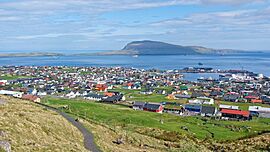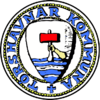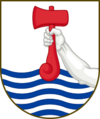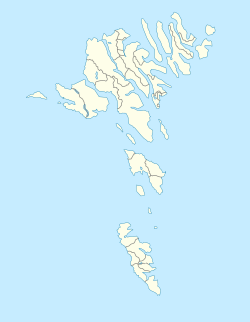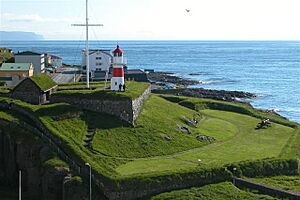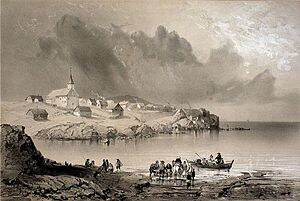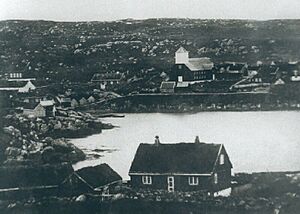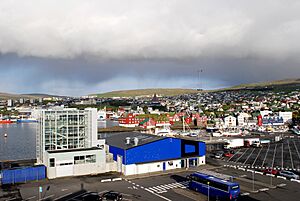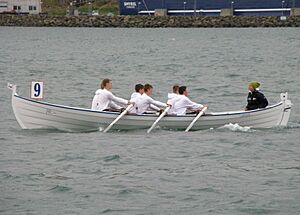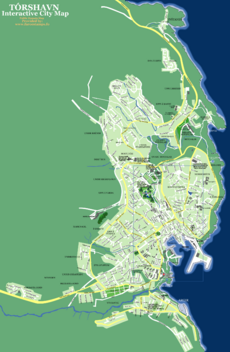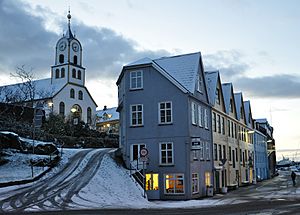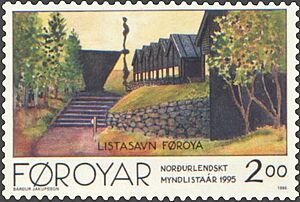Tórshavn facts for kids
Quick facts for kids
Tórshavn
|
|||||
|---|---|---|---|---|---|
|
Panoramic, Faeroese Parliament, Tinganes, Tórshavn Cathedral, Lighthouse, The old township, Central Tórshavn, The Nordic House, View of Tórshavn,
|
|||||
|
|||||
| Nickname(s):
Havn
|
|||||
| State | Danish Realm | ||||
| Constituent Country | Faroe Islands | ||||
| Municipality | |||||
| Founded | 9th century | ||||
| Town rights | 1909 | ||||
| Elevation | 24 m (79 ft) | ||||
| Population
(January 2024)
|
|||||
| • City | 14,099 | ||||
| • Urban | 23,194 | ||||
| population-ranking: 1st | |||||
| Time zone | UTC±00:00 (WET) | ||||
| • Summer (DST) | UTC+01:00 (WEST) | ||||
| Postal code |
FO-100, FO-110
|
||||
| Climate | Cfc | ||||
Tórshavn is the capital and largest city of the Faroe Islands. Its name means "Thor's harbour," named after the Norse god Thor. People often call it simply Havn.
Tórshavn is located on the east coast of Streymoy, which is one of the Faroe Islands. Two mountains, Húsareyn and Kirkjubøreyn, are near the city. The Sandá River runs between them. The city itself has about 14,099 people (as of 2024). If you include nearby areas like Hoyvík and Argir, the total population is around 23,194.
The Norsemen (Vikings from Scandinavia) started their parliament here in 850 AD. This made Tórshavn the capital of the Faroe Islands, and it has been ever since. For a long time, Tórshavn was the only place where islanders could legally buy and sell goods. This was called a trade monopoly. In 1856, this monopoly ended, and the islands could trade freely.
Contents
History of Tórshavn
Early Beginnings
We don't know if Irish monks, who were likely the first settlers in the Faroes, were interested in the area where Tórshavn now stands. Viking settlers in the 9th century set up their own parliaments, called tings. They usually held these meetings in neutral, empty places.
The main ting for the islands was held in Tórshavn around 825 AD. It took place on Tinganes, a peninsula that splits the harbour into two parts: Eystaravág and Vestaravág.
The settlers would meet on the flat rocks of Tinganes every summer. It was the most central spot on the islands. At that time, there wasn't a town there. An old Viking story, the Færeyinga Saga, says: "the place of the ting of the Faroese was on Streymoy, and there is the harbour that is called Tórshavn." The Viking Age ended in 1035. After the ting, a market grew, which slowly turned into a permanent trading area.
For many centuries, the narrow Tinganes peninsula was the main part of Tórshavn. It was different from other Faroese villages because it was never just a farming community. By the 12th century, all trade between Norway and the Faroes was handled in Bergen.
In 1271, the Norwegian king created a royal trade monopoly in Tórshavn. This meant that only two ships from Bergen would regularly sail to Tórshavn. They brought salt, wood, and grain. Because of this, Tórshavn had more contact with the outside world than other villages. Government officials from Norway and later Denmark also lived in Tórshavn. All these things, plus being the place of the ting, helped the town grow.
From 1500 to 1800
There isn't much mention of buildings in Tórshavn until after 1539. Around 1580, a small fort called Skansin was built by a Faroese hero named Magnus Heinason. It was at the north end of the harbour. Later, more small forts were built at Tinganes.
In 1584, Tórshavn had 101 people. They were divided into three groups: farmers and their families, trade and government workers, and people who didn't own land. The landless people often came to Tórshavn looking for work. They sometimes had to guard Skansin without pay, relying on farmers for food and clothes.
From 1655 to 1709, the Faroe Islands were ruled by the Gabel family. This time was known as Gablatíðin and was a difficult period for Tórshavn. The Gabel family controlled all trade, and it didn't help the Faroese people. People had to sell their goods for whatever price they were offered. Imported goods were expensive and hard to get. There were many complaints about unfair treatment. In 1673, a fire destroyed many old houses in Tinganes after gunpowder exploded. Many old Faroese records were lost.
Things got better in Tórshavn when the trade monopoly became a royal monopoly in 1709. The Danish royal trade monopoly brought goods from Copenhagen three times a year. However, in 1709, a smallpox outbreak killed most of the population. Before the disease, the town had 300 people, but 250 died.
Still, Tórshavn began to grow into a small town in the late 1700s. This was when Niels Ryberg managed the trade monopoly. He was allowed to trade goods, often by smuggling them to England. His warehouses in Tórshavn filled up with goods. Ryberg was also the first to think about making money from fishing, which later became very important for the islands.
Tórshavn Cathedral was first built in 1788. It was partly rebuilt in 1865. Since 1990, it has been the main church for the Bishop of the Faroe Islands.
From 1800 to Today
In 1808, during a war between Britain and Denmark, a British ship called HMS Clio captured the fort at Skansin. The fort gave up without a fight. The British took the fort's weapons before leaving. Later, a German privateer (a private ship allowed to attack enemy ships) attacked the city and took goods from the Danish Crown Monopoly.
In 1856, free trade came to the Faroe Islands. This changed the economy a lot, and Tórshavn became the main center for trade.
In 1866, Tórshavn's town council was created. The town has been the capital ever since. In 1909, Tórshavn became a market town, similar to Danish market towns. In 1927, Tórshavn got a modern harbor. This allowed larger ships to dock there.
During World War II, Skansin fort was used by the British Royal Navy.
Over the years, several nearby villages joined Tórshavn. In 1974, Hoyvík and Hvítanes became part of the town. Later, Kaldbak (1978), Argir (1997), Kollafjørður (2001), and Kirkjubøur, Hestur, and Nólsoy (2005) also joined the Tórshavn municipality.
Climate and Weather
| Weather chart for Tórshavn, Faroe Islands | |||||||||||||||||||||||||||||||||||||||||||||||
|---|---|---|---|---|---|---|---|---|---|---|---|---|---|---|---|---|---|---|---|---|---|---|---|---|---|---|---|---|---|---|---|---|---|---|---|---|---|---|---|---|---|---|---|---|---|---|---|
| J | F | M | A | M | J | J | A | S | O | N | D | ||||||||||||||||||||||||||||||||||||
|
165
6
2
|
128
6
2
|
128
6
2
|
91
8
3
|
68
9
5
|
62
11
7
|
70
13
9
|
92
13
9
|
116
12
8
|
145
10
6
|
152
8
4
|
154
7
2
|
||||||||||||||||||||||||||||||||||||
| temperatures in °C precipitation totals in mm source: Danish Meteorological Institute |
|||||||||||||||||||||||||||||||||||||||||||||||
|
Imperial conversion
|
|||||||||||||||||||||||||||||||||||||||||||||||
Tórshavn has a cool, wet climate. It's called a subpolar oceanic climate. The Atlantic Ocean keeps the temperatures mild. In winter, Tórshavn is often cloudy and stormy. This is because of a weather system called the Icelandic Low. Winter daytime temperatures are usually around 6°C (43°F), which is quite mild for how far north it is.
However, summer temperatures are not very warm. They rarely go above 13°C (55°F) in the warmest month. The ocean also keeps the temperature from changing too much. The difference between the hottest and coldest temperatures ever recorded is only about 33°C (59°F). Even in winter, the average low temperatures stay above freezing.
The most rain falls in autumn and winter, especially in January. May, June, and July are drier, but still get a good amount of rain.
| Climate data for Tórshavn (1991–2020, extremes 1961–2021) | |||||||||||||
|---|---|---|---|---|---|---|---|---|---|---|---|---|---|
| Month | Jan | Feb | Mar | Apr | May | Jun | Jul | Aug | Sep | Oct | Nov | Dec | Year |
| Record high °C (°F) | 11.6 (52.9) |
13.0 (55.4) |
12.3 (54.1) |
18.3 (64.9) |
19.7 (67.5) |
20.0 (68.0) |
20.2 (68.4) |
22.0 (71.6) |
19.5 (67.1) |
16.3 (61.3) |
14.7 (58.5) |
13.2 (55.8) |
22.0 (71.6) |
| Mean daily maximum °C (°F) | 6.2 (43.2) |
6.0 (42.8) |
6.4 (43.5) |
7.6 (45.7) |
9.3 (48.7) |
11.3 (52.3) |
12.9 (55.2) |
13.3 (55.9) |
11.9 (53.4) |
9.6 (49.3) |
7.6 (45.7) |
6.5 (43.7) |
9.0 (48.2) |
| Daily mean °C (°F) | 4.3 (39.7) |
4.0 (39.2) |
4.3 (39.7) |
5.5 (41.9) |
7.1 (44.8) |
9.1 (48.4) |
10.8 (51.4) |
11.2 (52.2) |
10.0 (50.0) |
7.8 (46.0) |
5.8 (42.4) |
4.5 (40.1) |
7.0 (44.6) |
| Mean daily minimum °C (°F) | 2.1 (35.8) |
1.6 (34.9) |
2.0 (35.6) |
3.2 (37.8) |
5.0 (41.0) |
7.3 (45.1) |
9.1 (48.4) |
9.3 (48.7) |
8.1 (46.6) |
5.7 (42.3) |
3.6 (38.5) |
2.2 (36.0) |
4.9 (40.8) |
| Record low °C (°F) | −8.8 (16.2) |
−11.0 (12.2) |
−9.2 (15.4) |
−9.9 (14.2) |
−3.0 (26.6) |
0.0 (32.0) |
1.5 (34.7) |
1.5 (34.7) |
−0.6 (30.9) |
−4.5 (23.9) |
−7.2 (19.0) |
−10.5 (13.1) |
−11.0 (12.2) |
| Average precipitation mm (inches) | 167.3 (6.59) |
131.2 (5.17) |
129.5 (5.10) |
95.4 (3.76) |
70.3 (2.77) |
63.1 (2.48) |
71.2 (2.80) |
93.4 (3.68) |
118.1 (4.65) |
146.8 (5.78) |
155.2 (6.11) |
157.7 (6.21) |
1,399.2 (55.1) |
| Average precipitation days (≥ 1 mm) | 20.7 | 17.3 | 18.9 | 14.7 | 12.2 | 9.2 | 11.0 | 12.9 | 15.9 | 19.0 | 19.8 | 20.4 | 192 |
| Average snowy days | 8.3 | 6.6 | 8.0 | 4.4 | 1.5 | 0.0 | 0.0 | 0.0 | 0.1 | 1.4 | 5.5 | 8.2 | 44.0 |
| Average relative humidity (%) | 89 | 88 | 88 | 87 | 87 | 88 | 89 | 90 | 89 | 89 | 88 | 89 | 88 |
| Mean monthly sunshine hours | 29.8 | 53.0 | 91.5 | 116.2 | 157.8 | 135.4 | 106.9 | 101.6 | 88.9 | 59.7 | 38.6 | 22.7 | 1,002.1 |
| Source: Danish Meteorological Institute (humidity 1961–1990, snowy days 1961–1990, sun 2007-2020), infoclimat.fr (record high) | |||||||||||||
| Coastal temperature data for Tórshavn | |||||||||||||
|---|---|---|---|---|---|---|---|---|---|---|---|---|---|
| Month | Jan | Feb | Mar | Apr | May | Jun | Jul | Aug | Sep | Oct | Nov | Dec | Year |
| Average sea temperature °C (°F) | 7.0 (44.60) |
6.6 (43.88) |
6.8 (44.24) |
7.0 (44.60) |
7.6 (45.68) |
8.5 (47.30) |
9.8 (49.64) |
10.5 (50.90) |
10.4 (50.72) |
9.8 (49.64) |
8.8 (47.84) |
8.0 (46.40) |
8.4 (47.12) |
| Source 1: Seatemperature.net | |||||||||||||
Sports in Tórshavn
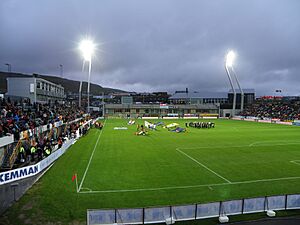
As the capital, Tórshavn is the main center for sports in the Faroe Islands. The biggest sports center is in the Gundadalur area. Here you'll find Tórsvøllur, the largest football stadium, which can hold 6,000 people. It's the home stadium for the Faroe Islands national football team.
Around the city, there are two other football fields, indoor tennis courts, badminton courts, and a swimming pool.
Tórshavn has several football clubs. Three of them play in the top league: HB Tórshavn, B36 Tórshavn, and Argja Bóltfelag. Other local football clubs include FF Giza (from Nólsoy), FC Hoyvík, and Undrið FF.
Handball is the second most popular sport. The city's handball teams are Kyndil, Neistin, and Ítróttafelagið H71. The Faroe Islands men's national handball team also practices here.
Tórshavn also has popular rowing clubs, like Havnar Róðrarfelag and Róðrarfelagið Knørrur.
Every July, the Tour of Faroe Islands bicycle race takes place. This road race, called Kring Føroyar, starts in Klaksvík and finishes in Tórshavn.
Music Scene
The Tórshavn Jazz Festival has been held every year since 1983. It brings in musicians from North America and Europe. It has become a popular event for tourists.
Getting Around Tórshavn
The harbour is a key transport hub. The Smyril Line ferry connects Tórshavn to Denmark and Iceland. There are also local ferry services, like the one to Tvøroyri, that connect different parts of the Faroe Islands.
Tórshavn has a local bus network called Bussleiðin. These red buses have five routes. Since 2007, buses within Tórshavn have been completely free to ride! There's also a helipad near the coast for helicopter travel.
Places to Visit
- Tinganes: This is the old part of town. It has small wooden houses with grass roofs, some as old as 500 years.
- Tórshavn Cathedral: This is the second oldest church in the Faroe Islands.
- Tórshavn harbour: A busy and historic port.
- Fort Skansin: A historic fort built in the 1500s.
- Listasavn Føroya: The Faroese art museum, where you can see local art.
- Vesturkirkjan: The main church, with outdoor artwork by Hans Pauli Olsen.
- The Nordic House in the Faroe Islands: An important cultural center for the Nordic countries.
- The historical museum in Hoyvík: It holds many valuable items from the past.
- The museum of Natural History: It has a small botanical garden with 150 types of Faroese plants.
- Niels Finsens gøta: Tórshavn's only street just for walking.
Important Institutions
- Løgtingið and Landstýrið: These are the Faroese parliament and government, where laws are made and the country is run.
- Kringvarp Føroya: This is the national TV and radio station, owned by the public.
- University of the Faroe Islands: The main university, along with other colleges for navigation and teaching.
- Postverk Føroya: The postal service of the Faroe Islands.
- Many countries have a Consulate-General in Tórshavn. These include all the Nordic countries and several countries from the European Union.
- Føroya Studentaskúli og HF-Skeið: The largest and oldest high school in the country, located just outside Tórshavn.
Famous People from Tórshavn
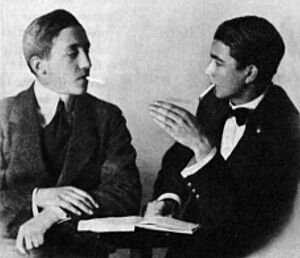
- Niels Ryberg Finsen (1860–1904): He won the Nobel Prize in Medicine in 1903.
- Petur Alberg (1885–1940): A composer, famous for writing the national anthem.
- William Heinesen (1900–1991): A well-known writer, poet, composer, and painter.
- Jørgen-Frantz Jacobsen (1900–1938): A famous writer.
- Týr: A popular folk metal band.
- Greta Svabo Bech (1987): A singer.
- Sarah Mahfoud (1989): A boxer.
- Helgi Dam Ziska (1990): A chess player.
- Reiley (1997): A singer and social media star.
Images for kids
Sister Cities
Tórshavn is connected with other cities around the world. These are called "sister cities" or "twin cities."
 Esbjerg, Denmark
Esbjerg, Denmark Birkerød, Denmark
Birkerød, Denmark Asker, Norway
Asker, Norway Garðabær, Iceland
Garðabær, Iceland Reykjavík, Iceland
Reykjavík, Iceland Jakobstad, Finland
Jakobstad, Finland Mariehamn, Åland
Mariehamn, Åland Eslöv, Sweden
Eslöv, Sweden Riolunato, Italy
Riolunato, Italy
See also
 In Spanish: Tórshavn para niños
In Spanish: Tórshavn para niños










